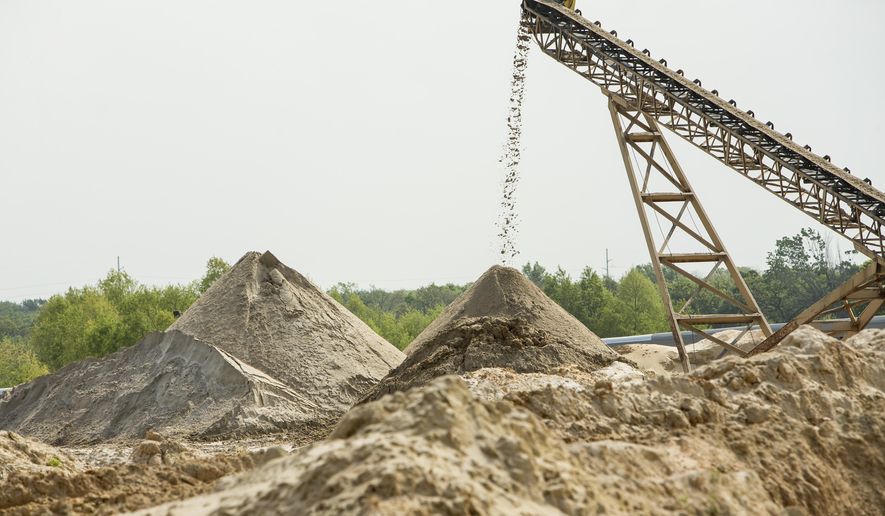KERMIT, Texas (AP) - Ten miles east of this community of 6,000 sandwiched between booming West Texas oil fields, heavy trucks have begun lining up at the region’s first sand mine as it churns out ammo by the ton for U.S. frackers.
The Houston Chronicle reports the $325 million mine, owned by Houston sand supplier Hi-Crush Partners, is the first working plant of its kind in West Texas, and over the next 18 months, rivals including U.S. Silica Co. and Fairmount Santrol plan to build more mines that will send millions of tons of sand into the Permian Basin, allowing oil producers to circumvent expensive rail lines that transport white sand from Wisconsin, one of the costliest obstacles in West Texas.
“It’s going to change the landscape for us,” said Chris Gatjanis, who runs the Permian Basin operations for Halliburton, the world’s largest hydraulic fracturing company. “If you can cut out a piece of the cost of getting the sand to location, it makes the economics out here work better.”
The burst of sand mine construction in the Permian Basin is the oil industry’s latest attempt to lower the cost of producing crude and make money at lower oil prices. The easy access to local sand mines and the savings in transportation costs from Midwestern sand operations is expected to slash sand costs by 40 percent, from about $140 a ton to $85, lowering cost of bringing a new well into production by another 5 percent and the break-even point for most drillers to less than $40 a barrel.
What this likely means is more oil coming out of the Permian and into over-supplied markets, and more downward pressure on prices. Near record U.S. production by increasingly efficient shale drillers has largely offset output cuts by OPEC, Russia and other major producers, and stalled what had been a steady climb in prices from the downturn’s bottom of $26 a barrel to as high as $54.
“Not only are they ramping up output, they’re also exporting more oil,” said John Kilduff, an oil market analyst at Again Capital. “That undercuts OPEC in a big way.”
Sand is a key ingredient in the slurry that frackers blast underground to crack dense rock formations, propping open the fissures to allow and oil and gas to escape. In recent years, oil companies have discovered many of their wells produce more oil with larger payloads of sand, and across the United States, they’ve greatly increased the amount of sand they use in each well, from an average of 5.3 million pounds of sand at the end of 2014 to 11.5 million pounds this year.
For one drilling site near Midland, Halliburton estimates it will need 400 trucks to bring all the sand it will pour underground. Each truck will carry at least 40,000 pounds of sand.
Two major rail lines, owned by Union Pacific and BNSF Railway, transport sand into the region, but there’s not enough capacity on those rail lines to carry all the sand West Texas oil companies need. Smaller operators often struggle to get enough sand for their well.
“The sand mines will take pressure off the system,” Gatjanis said. “That’s one advantage the Permian is going to have next year compared to other areas. And it’s the one thing people haven’t factored in that’s going to keep our costs down. It’s huge.”
Several of the region’s next sand mines are expected to come online in the first half of next year, supplying oil companies the 25,000 tons per well they plan to use for the largest wells in the Permian Basin. That’s up from just 1,500 tons a few years ago.
All told, sand companies have announced plans to add production capacity of around 55 million tons of sand a year over the next 18 months, though analysts expect some of those projects will be canceled and the added capacity will come in around 35 million tons per year.
Still, what has been left untested is whether each oil producer in the Permian Basin will abandon the white sand producers in Wisconsin - an unlikely prospect, because some drillers prefer the tough, white grains over their brown counterparts produced in Texas, said Ryan Carbrey, director of onshore services at IHS Markit in Houston. The white sand grains transported from Wisconsin are typically more durable underground in high pressures than brown sand produced in West Texas, making it more reliable for hydraulic fracturing.
“We’ve heard of some operators who are skeptical, but others are willing to use West Texas sand,” he said.
Analysts say there will be plenty of demand to support mines in both Texas and Wisconsin. Next year, oil producers in the Permian Basin will account for one-third of the demand for sand in the United States, at 33 million tons per year in 2018, growing to roughly 50 million tons per year in 2022.
Hi-Crush began producing and selling sand at its Kermit area facility, which produces 3 million tons of sand per year, at the end of last month, two months ahead of schedule. All that sand would take 120,000 separate truckloads to transport to well sites, according to IHS Markit.
“It’s a big market for us,” said Laura Folton, chief financial officer of Hi-Crush in Houston. “They’re using a heck of a lot more sand in each well.”
___
Information from: Houston Chronicle, https://www.houstonchronicle.com




Please read our comment policy before commenting.